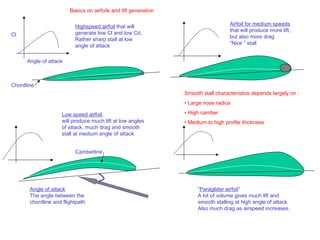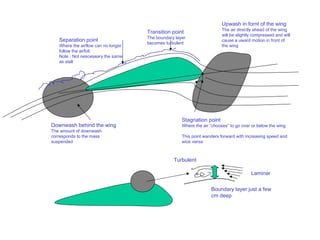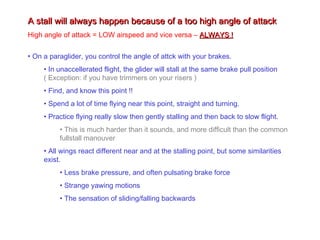Basics on airfoils and lift generation
- 1. Basics on airfoils and lift generation Highspeed airfoil that will Airfoil for medium speeds that will produce more lift, Cl generate low Cl and low Cd. but also more drag Rather sharp stall at low ŌĆØNice ŌĆØ stall angle of attack Angle of attack Chordline Smooth stall characteristics depends largely on : ŌĆó Large nose radius Low speed airfoil, ŌĆó High camber will produce much lift at low angles ŌĆó Medium to high profile thickness of attack, much drag and smooth stall at medium angle of attack Camberline Angle of attack ŌĆØParaglider airfoilŌĆØ The angle between the A lot of volume gives much lift and chordline and flightpath smooth stalling at high angle of attack Also much drag as airspeed increases.
- 2. Upwash in fornt of the wing The air directly ahead of the wing Transition point will be slightly compressed and will The boundary layer Separation point cause a uward motion in front of becomes turbulent Where the airflow can no longer the wing follow the airfoil. Note : Not nesceseary the same as stall Stagnation point Downwash behind the wing Where the air ŌĆØchoosesŌĆØ to go over or below the wing. The amount of downwash corresponds to the mass This point wanders forward with increasing speed and suspended wice versa Turbulent Laminar Boundary layer just a few cm deep
- 3. There will always be some degree of separation behind a wing during normal flight. Dunamic pressure If we increase angle of attack, this point moves forward. A stall Follows when this point has moved sufficient far forward, and typhical at around 30% of chordline. Static pressure Total pressure = Static + Dynamic ( Bernoullis law ) High dynamic, low static pressure 0 velosity ! Kritisk zone High static pressure moves up and around te trailing edge to equalize the low pressure there. The airflow can not follow the airfoil due to the velosity decrease past the highest point of the airfoil Low dynamic, high static High pressure air from below moves up the pressure back of the airfoil, flowing against the direction of flight, Where the total velosity reaches 0 , Low pressure !! separation follows. Angle of attack Negativ flow ! Stall !! High Pressure !!
- 4. A stall will always happen because of a too high angle of attack High angle of attack = LOW airspeed and vice versa ŌĆō ALWAYS ! ŌĆó On a paraglider, you control the angle of attck with your brakes. ŌĆó In unaccellerated flight, the glider will stall at the same brake pull position ( Exception: if you have trimmers on your risers ) ŌĆó Find, and know this point !! ŌĆó Spend a lot of time flying near this point, straight and turning. ŌĆó Practice flying really slow then gently stalling and then back to slow flight. ŌĆó This is much harder than it sounds, and more difficult than the common fullstall manouver ŌĆó All wings react different near and at the stalling point, but some similarities exist. ŌĆó Less brake pressure, and often pulsating brake force ŌĆó Strange yawing motions ŌĆó The sensation of sliding/falling backwards
- 5. Stall VS Spin ŌĆó By reason of the way a paraglider is rigged; a stall can quickly lead to a spin ŌĆ” ŌĆó Almost without exception, when a pilot uncontrolled hits the ground, there has been a rotation before impact. ŌĆóThe glider stalls, and a rotation develops into a spin ŌĆ” ŌĆó After a collapse, the glider enters a spiral or enters a spin due to overcorrection by the pilot. Paraglider ŌĆō Wash IN ŌĆó To increase resistance to collapses, the tips fly with a bit higher angle of attack than the center. ŌĆó This leads to the tips stalling before the center. ŌĆó The tip section is the most effective generator of or d lateral control. Tip ch Center chord When this portion of the wing stalls, directional control is lost ŌĆ” ŌĆó The wing enters a spin. Airplane/ Hangglider ŌĆō Wash OUT ŌĆó To prevent spins, the tips fly at a slightly lower angle of attack. ( This can be done by geometric or aerodynamic washout ) ŌĆó The center will stall first, and directional control remains also after a stall
- 6. My ŌĆØto doŌĆØ list after a big collapse The glider flies again ! Remember : It is always worse to do too much after a collapse. Keep 20 % on the left side; if the wing does not open: Relax, let the glider fly, preserve airspeed. ŌĆó Apply right brake in long controlled strokes Do not pull the glider into a spin as you try hard to ŌĆó Do not pump short, quick strokes reopen ŌĆ” ŌĆó Do not overdo this, SPIN DANGER ! Keep 20 % brake, lef and right .. ŌĆó Wait a bit to see what the canopy does now, many times it will reopen by itself ŌĆó Axcept a certain heading change DO NOT try hard to keep heading ŌĆō danger of spin !! ŌĆó Apply about 20 % brake, both sides 60 % collapse ŌĆ”, rapid right turn induction Full speed ahead ŌĆ”
- 7. Nasty situations where the glider might stall unexpected .. Rapid sink ŌĆó You are flying slowly ŌĆ” ŌĆó Suddenly you enter heavy sinking air ŌĆ” ŌĆó Flightpath becomes steeper, angle of attack becomes greater ŌĆ”. ŌĆó The glider might stall ŌĆ”.. ŌĆó Release brakes a bit if entering heavy, sudden sink
- 8. Nasty situations where the glider might stall unexpected .. Entering rapid rising air Despite constant braking, the glider stalls ŌĆ” ŌĆó You are flying slow, near the terrain ŌĆ” ŌĆó The inner wing is suddenly lifted ŌĆ”. ŌĆó This wing will increase it`s angle of attack due to the vertical component of relativ windŌĆ”. ŌĆó The glider stalls this wing and spins into the terrain ŌĆ” ŌĆó Increase airspeed a bit when close to the terrain
- 9. Nasty situations where the glider might stall unexpected .. Wind gradient / windshear means that the wind speed or direction changes rapidly Wind gradient with altitude or distance. Severity will increase with the roughness of the terrain below. Wind speed Airspeed ŌĆó You are flying above the windshear and are maintaining slow, but safe airspeed ŌĆó You enter the windshear, and suddenly your airspeed falls quickly ŌĆ” ŌĆó Lift is reduced, and the flightpath becomes steeperŌĆ” ŌĆó Angle of attack increases further ŌĆ” ŌĆó A stable glider will tend to pitch forward, and a common mistake is to apply brake to compensate for this ŌĆ”. ( NOT GOOD !! ) ŌĆó The already high angle of attack increases even more ŌĆ” ŌĆó The glider stalls ŌĆ”. ŌĆó Release the brakes a bit when entering a wind gradient ŌĆó Allow the glider some forward pitchingŌĆ”.
- 10. ŌĆó Maintain your airspeed ŌĆ” ŌĆ”ŌĆ” ŌĆ” and avoid this ŌĆ”









